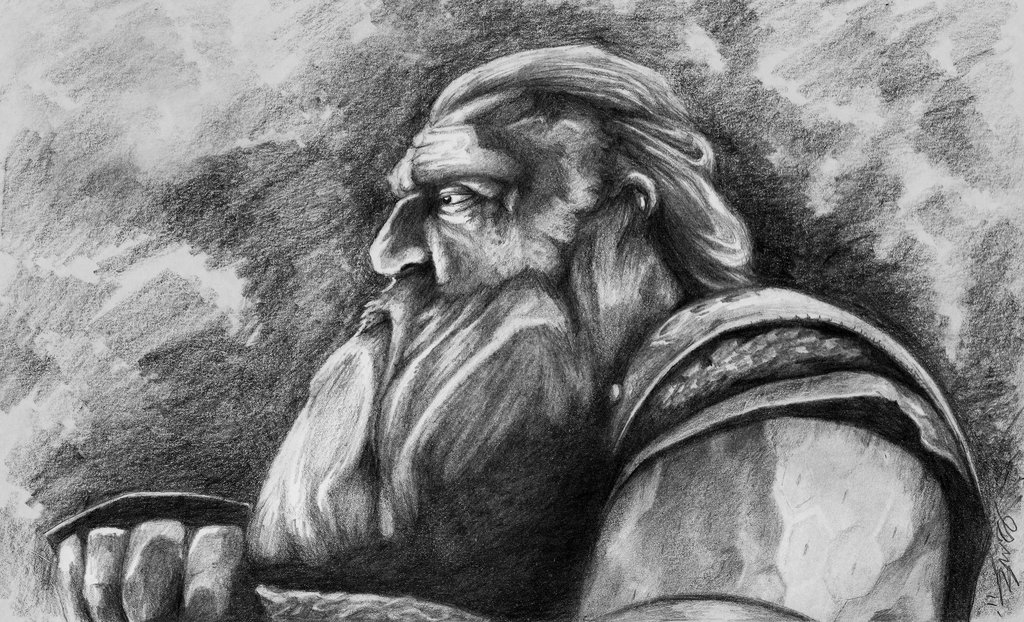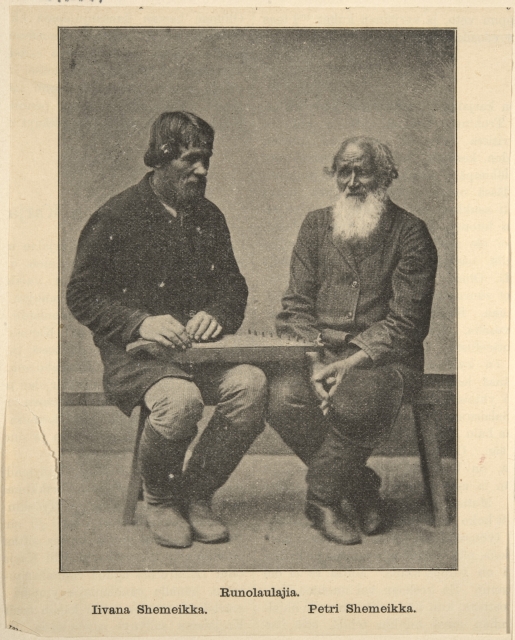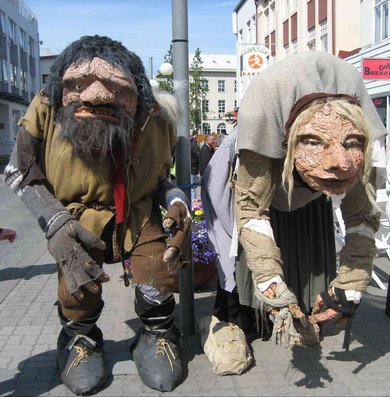Folklore in the Nordic countries
Folklore is a phenomenon found in all cultures. Falling under the umbrella of what is now called ‘intangible cultural heritage’ by UNESCO, it encompasses everything from Finnish improvisational rap and medieval eddic poetry to internet memes or wearing a crown of candles on St Lucia’s day. Nordic folklore research has played a significant role in establishing folklore studies as a discipline and has made an impact on folklore research around the world.

What is folklore?
Folklore surrounds us and encompasses everything from internet memes and popular sayings that are part and parcel of everyday life, to the metamorphoses of folklore from other times or cultures in best-selling novels or children’s television programmes. If something seems to belong to our own world, we often don’t think of it as folklore, although Finnish improvisational rap is no less a form of folklore than are Faroese ballads. We tend not to consider something as folklore before it seems out of sync with the familiar or what we see as natural, like putting lit (or fake) candles on your head on St Lucia's Day. Moreover, things belonging to a remoter past might be seen as something else entirely, yet medieval eddic poetry and much in the Icelandic sagas represent the folklore of their time. Folklore is everywhere, from the classroom to Instagram.
‘Folklore’ has been defined in all sorts of ways. It is used alongside a number of other terms like ‘tradition’, ‘folklife’, ‘folk music’ and so on that may be considered distinct or be lumped together as part of folklore. In the Nordic countries, folklore has been conceived as categories of cultural knowledge and practice, normally qualified by three criteria (which have, however, often remained implicit):
- Competence in folklore is developed through social interaction without a single, unifying authority like an institutionalised education or a book; interaction can be technologically mediated, for example by phone or the internet, but variation, which is characteristic of folklore, is an outcome of how it is learned and used.
- Folklore is made of units that mean things, whether these are words of language or motifs that might be in stories, enacted or even avoided, like breaking a mirror as bad luck; this distinguishes folklore from other types of knowledge and practice like competence in folk music or how to chop firewood.
- Folklore is socially shaped by imagination and/or aesthetics, from poetics to knowledge of things contradictory to modern science, like ghosts, or simply learned through discourse, like ‘germs’ as invisible agents or the Big Bang creation story (so-called ‘beliefs’); this distinguishes folklore from sign systems like language.
As the concept has developed in Nordic research, folklore can thus be defined as:
socially mediated and negotiated knowledge or competence in sign-based codes of expression, behaviour or understanding that are linked to imagination or aesthetics.
In the United States, for example, folklore does not customarily include the criterion of units that mean things (sign-based codes), so folklore commonly includes folk music, handicrafts, foodways and so forth, making it synonymous with the broader concept of tradition. Drawn informally from peers and predecessors, folklore, in all these definitions, provides models and resources for things we express and the ways in which we express them, resources for structuring our behaviour and understanding what we encounter or observe in the world around us.
Folklore in which we participate as a natural or essential part of family or social life is often overlooked.
|
Folklore and changing communication technologies
Orality and literacy have often been imagined as mutually exclusive categories, as have technology and folklore more generally. These are, in fact, complementary; folklore is a resource for everything from blogs and film to advertising and political speeches, which reciprocally inform and impact folklore. New modes of communication have affected the consumption and dissemination of established folklore genres. The roles and social value of those genres have simultaneously been restructured in relation to, for example, alternative forms of entertainment (e.g. television), new authoritative informational resources (e.g. books) and an increased reliance on specialists (e.g. doctors). Genres have disappeared or been transformed or reborn through literature, and new genres have emerged.
Electronic communication and rapidly increasing mobility have reshaped existing communities and given rise to new ones (e.g. virtual). In some cases, these have radically altered shared frames of reference (e.g. chatrooms), while in others, they have enabled a sense of common participation in social events over enormous geographical areas (e.g. televised sports). On the internet, electronic written communication has displaced orality as a central mode of folklore use, where ‘performance’ must be redefined as a ‘communicative event’ increasingly augmented by graphics, gifs and video.
Internet users commonly refer to anything that spreads widely and rapidly through their networks as a ‘meme’, but the term is also used more narrowly for a kind of internet folklore that combines an image (or video) with a usually short and humorous text. Variations of the ‘Batman Slapping Robin’ meme have become a classic example of the genre. "Prata Svenska" means "Talk Swedish!" Picture: imgflip.com.
Multicultural environments frequently shift the common language to English, especially among Nordic populations where English is an accepted lingua franca. Globalisation has generated new contexts in which the individual, social group and ethnic identities are understood, negotiated and contested. New social environments (e.g. YouTube, Twitter, online gaming) present new types of identities dislocated from physical social realities. New forms of folklore reflect the development of new practices as common frames of reference (e.g. netiquette) in which these identities are constructed and negotiated. This folklore reciprocally impacts local communities while the global arena stimulates awareness of local and ethnic folklore as generally significant and as a resource in marking identity.
Nationalism and different ways of imagining folklore
Throughout much of the twentieth century, folklore was generally conceived as the ‘lore’ of the common people or ‘folk’. People who were educated, literate and modern collected and talked about this ‘lore’ as part of their own past, lifting it from peasant communities, cleaning it up and turning it into ‘things’ of heritage that could be published in books and used for building national identities. Folklore was seen as the spiritual reserve of the intellectually inferior ‘other’ – the ‘folk’ – who luckily had preserved it for people who knew better. This notion is in the background when the word ‘folklore’ is used to refer to stories or practices of historically remote societies, or something from cultures considered ‘other’. It is also why people sometimes call things in our own culture ‘folklore’ in order to imply naïveté or factual error: “Oh, that’s just folklore!”
Ideas of what folklore is (and is not) developed somewhat independently in different parts of Europe and North America during the nineteenth and early twentieth century. Differences in notions of folklore were linked to the different things people brought into focus in the Nordics, in the United States and elsewhere, for example oral poetry and song were important in the Nordics but initially separated from folklore in England. In the Nordics and elsewhere, the intoxicating links of folklore to nationalism can be imagined as a bubble that was burst by World War II. By that time, genres around which the term folklore emerged had disappeared from much of Europe (e.g. oral fairy tales) or radically transformed (e.g. belief legends). Folklore’s pre-war and wartime use as an instrument of nationalism placed it under a dark cloud, which also affected what was considered folklore or whether the term was used at all. In several countries, folklore research dissolved into ethnology, as happened in Sweden and later to a great extent in Norway and Denmark, while elsewhere it was absorbed for instance by anthropology.
In Denmark, Norway and Sweden, medieval literature and Viking Age archaeology held the spotlight in building national identities, making it easier for folklore to be marginalised. In Finland, folklore held centre stage; the nineteenth-century national epic Kalevala was created from oral, so-called ‘kalevalaic’ poetry, which tied folklore research to national identity, helping it to maintain an independent disciplinary identity. In Iceland, folklore research became linked to ethnology but has been gaining momentum. This appears connected to the vitality of Icelandic traditions related to elves, the hidden people and so forth that largely disappeared from Scandinavia and which have become valuable in building a distinct Icelandic identity.

By the end of the nineteenth century, traditional singers became iconic of Finnish national heritage, appearing in staged performances and in arranged photos, like Iivana and Petri of the famed Shemeikka family of epic singers in this photo from 1890. By 1900, Kalevala was recognised as a literary work of Eilas Lönnrot: research on poetry and mythology seen as a heritage of the past had to start from the folklore collected from singers such as these. In turn, this made folklore research of national interest. Photo: National Board of Antiquities - Musketti (CC BY 4.0).
Contrasting ‘folk’ as ‘primitive’ or ‘peasant’ with ‘modern’ was gradually overcome across especially the last third of the twentieth century. Early, narrow definitions of folklore were opened up and it was recognised as a common cultural phenomenon that can now be found on the internet, in medieval manuscripts or when visiting a local pub. However, the changes that followed WWII also created diversity even within the Nordics, where research and discussions have not been unified and where scholars are increasingly networking internationally.

After a thousand years, the huldufolk ‘hidden people’ finally show themselves on the streets in Iceland, driven from the concealment of their homes by the clamour of the tourist industry. Photo: David Stanley from Nanaimo, Canada, Folklore Figures, Akureyri (4899034211), Cropped version (CC BY 2.0).
Archives in the Nordic countries
The Nordic countries have rich resources for folklore research. Historically, research has focused on poetic and narrative oral traditions and on traditions associated with ‘beliefs’. Traditions were hierarchised with those closest to these foci becoming prestige genres (e.g. epic, incantation), and lively documentation projects produced huge collections of texts. For example, the Finnish Literature Society has the largest folklore archive in the world, with approximately four million items of collected folklore. Ongoing projects are increasing accessibility through digitising collections, ranging from the early Norwegian ballad database, to the Finnish Literature Society’s ever-evolving digital edition of over 87,000 items of kalevalaic poetry, or the Icelandic belief legends database with its geographical mapping functions.
The collection of folklore did not stop as the prestige genres disappeared. Modern cultural practices are actively documented and the internet has become an important medium for collecting living folklore, although ethical considerations prevent these collections from immediately becoming open-access. The earlier valuation hierarchies have significantly broken down, but the old prestige genres remain prominent owing to their establishment in academic discourse and their ability to capture popular imagination.
Folklore research in the Nordics from the nineteenth century to today
The Nordic countries played a pivotal role in early folklore research which was primarily text-oriented and affiliated with philology, linguistics, historiography and medieval studies. It sought to reconstruct texts as idealised heritage objects. That aim is now considered naïve and problematic, yet the development of methodologies by early Nordic researchers was fundamental to establishing folklore studies as a distinct discipline. Internationally, the shift from viewing folklore as text to a greater focus on performance and practice led folklore studies to realign with ethnology, anthropology and discourse studies.
Today, both present and past folklore are addressed as phenomena that live in society and as resources for creative and communicative expression. The social construction and contestation of heritage is now a subject of research rather than its goal, and ethics of using ‘intangible cultural heritage’ is a vital issue. ‘Texts’ are viewed as only one aspect of performance/discourse: context and intersubjective understandings are emphasised. The individual is elevated at the intersection of actual social situations and competence in folklore, looking at how folklore is used and its relationship to functionality (e.g. negotiating beliefs, developing personal relationships).
Relationships between folklore and identities are central, such as how personal and social identities impact on the selection and use of folklore, and how folklore is used to construct personal, social and ethnic/national identities. Whereas genres and text typologies were earlier viewed as prescriptive ideal categories, now these are examined as resources that people learn, use, combine and manipulate. Earlier emphasis on prestige genres like epic, legend or ballad has shifted to genres which can be documented today, among which modes and genres of narration hold prominence, particularly with regard to how individuals realise themselves, memories, history, social groups and ways of thinking through narrative. The orality–literacy opposition has given way to the examination of the interaction between these modes and now focuses on their rapid development through new technologies and social media.
Folklore research is an international field. In the Nordic countries, it is significantly concerned with non-Nordic cultures. Institutions and archives network substantially with institutions abroad (e.g. in India and China). Although folklore is universal, ‘folklore’ is not uniformly defined. The definition above reflects Nordic research perspectives, which are themselves far from uniform. This definition would probably be far narrower in India, where prestige genres such as oral epic are still vital, while the limits of its flexibility are tested in the United States, where many Eurocentric prestige genres have never existed as such. As a category, folklore is socially constructed, and, as a category, it is itself socially defined and negotiated in traditions of scholarship and popular discussion.
Further reading:
- John Miles Foley, Oral tradition and the internet: pathways of the mind (Urbana: University of Illinois Press, 2012).
- Marth C. Sims and Martine Stephens. Living folklore: an introduction to the study of people and their traditions Second revised edition. (Logan: Utah State University Press, 2011).
- P. Anttonen, Tradition through modernity: postmodernism and the nation-state in folklore scholarship (Helsinki: Finnish Literature Society, 2005).
- Regina Bendix and Galit Hasan?Rokem, A companion to folklore (London: Blackwell, 2012).
- Simon J. Bronner, Folklore: The Basics (Oxon: Routledge, 2017).
Links:
- Finnish Literature Society
- digital edition kalevalaic poetry
- Icelandic Belief Legends Database
- Norwegian ballad database